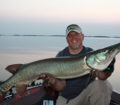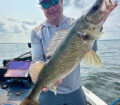Most of the time deer seem like ghosts walking through the woods. For the hunter it might sound like the forest is filled with everything but deer. In reality, though, deer are quite vocal animals, and they express themselves with a variety of noises that all mean different things, from warnings to sweet talk.
Knowing these sounds is essential to the effective hunter. Not only can they let him know where deer are and what they’re doing, but certain sounds may repel or attract certain types of deer at certain times. It might sound complicated, but there are definitely harder languages to learn.
What sounds does a deer make when scared or nervous?
One of the things that have helped deer survive for so long is their herd mentality. They take care of each other. One way they do that is by warning each other when there’s danger. Specifically, there a few sounds you should be aware of because if you hear them, it probably means a deer knows you’re around and has just alerted the rest of the herd.
Sniffs
If a deer begins to sense something is off, they may start making sniffing sounds. Not only are they trying to get a better smell, one of the easiest ways they can find you out, but they’re also putting the rest of the herd on edge. The sniff doesn’t sound much different than a human sniff, only stronger and deeper. Imagine air being sucked in through a deer’s large nose.
Stomps
Along with sniffing, suspicious deer may begin lightly stomping their hooves. This happens when they first suspect danger but aren’t quite sure where or what it is yet.
The noise sounds just like a wood block striking the ground and is usually noticeable since the deer are otherwise as silent as mice. The stomping puts the rest of the herd on alert so that they can more easily pinpoint the threat.
Snorts
The snort happens when a deer is positive there’s danger around. It means whatever methods you’ve employed to camouflage your body, noises and scents haven’t been enough. The snort sounds similar to a human sneeze, and nothing is more disheartening than hearing it off in the distance just when you’ve given up for the day and decided to start making your way out of the woods. The deer will snort, raise its tail and run away. The sound will alert other deer, and they’ll all do the same.
What sounds does a deer make when angry?
When they’re in the rut, male deer shed some of their usual cautiousness in order to chase the does. This certainly applies to their sounds as well, and a buck in the rut will be a lot louder than usual. In fact, he’ll make a variety of sounds to intimidate other bucks or warn them of his presence, and he’ll respond to sounds that make him think there’s another male around. He’ll make sounds to try to seduce the does as well.
Buck Grunt
Bucks make a loud grunting sound to show their dominance. While all deer make soft, long grunts to call to one another, the deep, short grunt of the buck is the male claiming the territory and does in it as his own. He’ll usually make it when he’s decided on a specific doe to chase, and he’ll continue making the grunts as he chases her. The sounds are also attractive to the females.
Rattling Antlers / The Buck Rattle
The buck rattle isn’t a vocalization of the deer. It’s the sound of two bucks fighting. When they spar, they clang their antlers together making a rattling sound. Before the rut begins, this can be light sparring just to size each other up, but when the does are in estrus, this becomes serious fighting to determine dominance.
If other bucks hear the sounds of antlers rattling, they know two males are fighting and will usually come to watch, especially the dominant buck of the area because he’ll want to know who’s fighting in his territory. This is why imitating this sound can attract them.
Snort-Wheeze
The snort-wheeze is an especially aggressive sound used to intimidate rivals. It sounds just like the name implies: a snort followed by a raspy wheeze. Two bucks vying for territory and does may make these sounds at each other to display their dominance. If one buck is smaller or more timid, the noise might send him running, but the more aggressive males usually make this sound just before they spar. This noise combined with the rattling antlers really gives the impression of a fight and will attract curious and dominant bucks to the area.
Other deer sounds
Being herd animals, deer need some way to communicate, and one of those ways is sound. They don’t just make noises to show fear or anger, but they also make different sounds when they’re excited, happy or even bored. Does especially have a wide range of vocalizations they use with each other and their fawns.
Doe Grunt
The grunt of a doe is much higher than that of a buck because the females have smaller bodies, and just like in humans, this results in a shorter airway. The does don’t grunt to show dominance, though. Basically, they just do it to talk to one another. Deer are highly social, and they try to gather together when they can, so a grunt is the deer’s way of telling others it’s around and ready to mingle, so to speak. The mothers also grunt to call the fawns if it’s feeding time or if they’re moving to a new location.
Doe Bleat
Does also bleat in social situations. The bleat is a higher-pitched vibrating sound, similar to that of a goat. They mostly do it when they are gathered together or with their fawns, and it signals contentment.
Doe in Heat Call – Estrus Bleat
When the does go into heat and are ready to mate, they make their own sound to seduce the bucks. This is the estrus bleat and it’s higher than the bucks’ calls. It almost sounds like a kazoo. When a doe wants to mate, she’ll stop and make the bleat which lets the buck chasing her know she’s ready. This can be one of the loudest noises deer make and is very distinctive.
What sounds does a baby deer make?
Baby deer, or fawns, make a lot of different noises to communicate with their mothers. The does have strong maternal instincts and respond quickly to calls from their babies. Consequently, if you’re hunting a doe, the best way to attract her may be to mimic the sounds of a fawn.
Nursing Whine
When the fawns are nursing or trying to nurse, they whine. It’s a rising and falling pitch that actually sounds a lot like a rusty screen door blowing in the wind, but the fawns make it to bond with their mothers. Like most social communication between deer, it is not audible from much of a distance.
Fawn Distress Call
If a fawn is in danger, it will call for its mother’s help. The call sounds like a loud continuous cry that can sometimes be eerily human. If it’s enough to make you feel like you need to go see what’s wrong, just imagine how it sounds to a mother deer. Does will normally come fast to find the crying fawn, even if their own babies are safe by their side. As you can imagine, the noise increases in volume depending on how much the fawn feels in danger. It might be quiet and rhythmic if the fawn is merely lost and looking for the herd, or it could be loud and panicked if it’s being chased by a predator. You’re mostly likely to hear this sound at the beginning of the season when fawns are still small and dependent on their mothers, and that’s also when you’ll have the best luck imitating it, though it can be successful year-round.
Fawn Bleat
Fawns also make a goat-like bleating sound similar to the does when they are happy. Because of their small bodies, the pitch is higher than that of the adults, but it serves basically the same purpose. The fawns bleat when they’re playing with each other or socializing with their mothers, and it encourages social bonding within the herd. You’re likely to hear young deer playing around and bleating while their mothers feed.




















